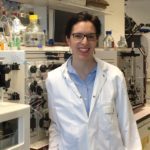Link to Pubmed [PMID] – 25392216
Link to DOI – 10.1128/JVI.02765-14
J Virol 2015 Jan; 89(2): 1364-76
Enveloped viruses utilize membrane fusion for entry into, and release from, host cells. For entry, members of the Herpesviridae require at least three envelope glycoproteins: the homotrimeric gB and a heterodimer of gH and gL. The crystal structures of three gH homologues, including pseudorabies virus (PrV) gH, revealed four conserved domains. Domain II contains a planar β-sheet (“fence”) and a syntaxin-like bundle of three α-helices (SLB), similar to those found in eukaryotic fusion proteins, potentially executing an important role in gH function. To test this hypothesis, we introduced targeted mutations into the PrV gH gene, which either disrupt the helices of the SLB by introduction of proline residues or covalently join them by artificial intramolecular disulfide bonds between themselves, to the adjacent fence region, or to domain III. Disruption of either of the three α-helices of the SLB (A250P, V275P, V298P) severely affected gH function in in vitro fusion assays and replication of corresponding PrV mutants. Considerable defects in fusion activity of gH, as well as in penetration kinetics and cell-to-cell spread of PrV mutants, were also observed after disulfide linkage of two α-helices within the SLB (A284C-S291C) or between SLB and domain III (H251C-L432C), as well as by insertions of additional cysteine pairs linking fence, SLB, and domain III. In vitro fusion activity of mutated gH could be partly restored by reduction of the artificial disulfide bonds. Our results indicate that the structure and flexibility of the SLB are relevant for the function of PrV gH in membrane fusion.Mutational analysis based on crystal structures of proteins is a powerful tool to understand protein function. Here, we continued our study of pseudorabies virus gH, a part of the core fusion machinery of herpesviruses. We previously showed that the “flap” region in domain IV of PrV gH is important for its function. We now demonstrate that mutations within domain II that interfere with integrity or flexibility of a syntaxin-like three-helix bundle also significantly impair gH function during fusion. These studies provide important insights into the structural requirements of gH for function in fusion.


